

Grit. 8 Important Characteristics Of Adult Learners. College Success Course. Students in the target population will enroll in one of several classes with embedded college success skills or a learning community that links a student success-type content with a degree requirement course.

This intervention will increase persistence rates in developmental level Reading and Writing courses by embedding College Success strategies into current course curriculum without adding credits or cost to students. Instructors work as a Faculty Learning Community (FLC) and embed instruction and practice in some of the following College Success skills that were identified by our broad-based College Success Strategy Team (CCST) . This FLC collaboratively built a bank of college success oriented assignments that are modularized and can be adopted by other faculty.
The assignments in our College Success Assignment Bank are tied to these specific Learning Outcomes identified by broad-based College Success Strategy Team: A. 1. 2. 3. 4. 5. 6. 7. B. 1. 2. 3 Strategies to Engage Millennials – We Aren’t That Different. As a millennial, I feel like we already have a bad reputation before even entering the workforce.
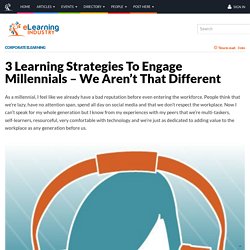
People think that we’re lazy, have no attention span, spend all day on social media and that we don’t respect the workplace. Now I can’t speak for my whole generation but I know from my experiences with my peers that we’re multi-taskers, self-learners, resourceful, very comfortable with technology and we’re just as dedicated to adding value to the workplace as any generation before us. In the corporate world, people are buzzing about millennials; they want to know how to capture our attention and engage us with training.
It’s exciting to see how training is evolving to incorporate learning strategies that millennials prefer to use like mobile, gaming, and video. Mobile LearningMillennials have grown up with mobile technology. It is exciting to see how training is changing to incorporate new technologies and learning techniques. Motivating Adult Learners - Motivational Strategies. Ames , C., & Archer, J. (1988).
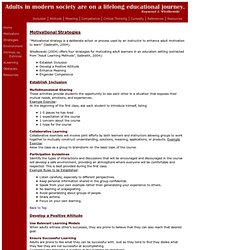
Achievement goals in the classroom: Students’ learning strategies and motivation processes. Journal of Educational Psychology, 80, 260–267. Ames , C. (1992a). 25 Tips to Help You Survive and Thrive Your Freshman Year. Printer-Friendly Version by Randall S.

Hansen, Ph.D. How to Survive -- and Excel in -- Your College Years Perhaps you were class president in high school. Or perhaps you were a member of the honor society. The 60-Second Guide To Engaging Your Learners. The 60-Second Guide To Engaging Your Learners In today's dynamic environment we know that you, as well as your learners are information overloaded and time poor.
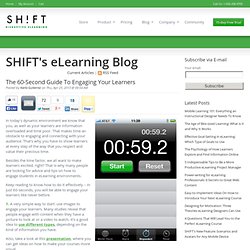
That makes time an obstacle to engaging and connecting with your audience. That's why you have to show learners at every step of the way that you respect and value their precious time. Besides the time factor, we all want to make learners excited, right? Data on whether and how students watch screencasts - Casting Out Nines. Screencasting is an integral part of the inverted classroom movement, and you can find screencasting even among courses that aren’t truly flipped.
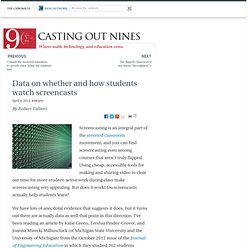
Using cheap, accessible tools for making and sharing video to clear out time for more student-active work during class make screencasting very appealing. But does it work? Do screencasts actually help students learn? We have lots of anecdotal evidence that suggests it does, but it turns out there are actually data as well that point in this direction. I’ve been reading an article by Katie Green, Tershia Pinder-Grover, and Joanna Mirecki Millunchick (of Michigan State University and the University of Michigan) from the October 2012 issue of the Journal of Engineering Education in which they studied 262 students enrolled in an engineering survey course that was augmented with screencasts. Notice: These screencasts weren’t mandatory, and this wasn’t a flipped classroom situation. This finding backs up my thoughts from this post. Online learning: It’s different. The number of online educational offerings has exploded in recent years, but their rapid rise has spawned a critical question: Can such “virtual” classes cut through the maze of distractions — such as email, the Internet, and television — that face students sitting at their computers?

The solution, Harvard researchers say, is to test students early and often. By interspersing online lectures with short tests, student mind-wandering decreased by half, note-taking tripled, and overall retention of the material improved, according to Daniel Schacter, the William R. Kenan Jr. Professor of Psychology, and Karl Szpunar, a postdoctoral fellow in psychology. Their findings are described in a paper published this week in the Proceedings of the National Academy of Sciences. Taking Lecture and Class Notes. Visual Notetaking. What Do We Mean by Results?:Using Rubrics to Promote Thinking and Learning. Motivation and Learning Strategies for College Success: A Focus on Self ... - Myron H. Dembo, Helena Seli. How to Get the Most Out of Studying. Motivating College Student Learning - Exploring How Students Learn.
RSA Animate - Drive: The surprising truth about what motivates us. Study Guides and Strategies. Learning Communities. Retention_Research_Brief. Online Student Retention Strategies: A Baker’s Dozen of Recommendations. December 7, 2012 By: Michael Jazzar in Online Education Despite the tremendous growth of online education programs, student retention for online courses remains problematic.
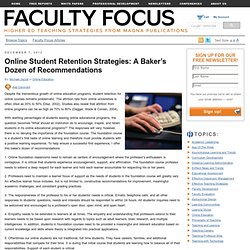
The attrition rate from online universities is often cited as 20% to 50% (Diaz, 2002). High-Impact Practices. A Brief Overview Excerpt from High-Impact Educational Practices: What They Are, Who Has Access to Them, and Why They Matter, by George D.
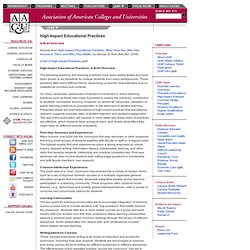
Kuh (AAC&U, 2008) Chart of High-Impact Practices (pdf) Student-Success Courses Hold Promise but Need Improvement, Study Finds - Students. By Caitlin Peterkin In an effort to improve retention and graduation rates, many institutions offer "College 101" courses alongside traditional academic ones: The goal is to teach students skills for success in the campus environment.
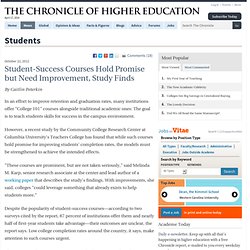
However, a recent study by the Community College Research Center at Columbia University's Teachers College has found that while such courses hold promise for improving students' completion rates, the models must be strengthened to achieve the intended effects. "These courses are prominent, but are not taken seriously," said Melinda M. Karp, senior research associate at the center and lead author of a working paper that describes the study's findings.